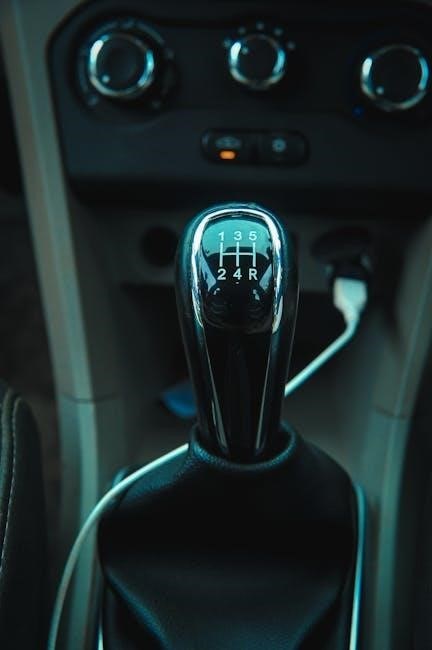driving classes for manual transmission

Manual transmission driving classes teach students to master vehicles with gear shifts and clutch pedals. These courses focus on developing coordination, control, and confidence behind the wheel.
1.1 What is a Manual Transmission?
A manual transmission, also known as a stick shift, is a type of gearbox that requires the driver to manually change gears using a clutch pedal and shift lever. It allows for precise control over the vehicle’s speed and torque, offering better fuel efficiency and driving engagement compared to automatic transmissions. This system is popular worldwide for its cost-effectiveness and performance benefits, making it a preferred choice for many drivers.
1.2 Benefits of Learning Manual Transmission
Learning manual transmission offers several advantages, including better fuel efficiency, lower maintenance costs, and increased control over the vehicle. It enhances driving engagement and skill, making it easier to handle various road conditions. Manual cars are often more affordable to purchase and repair. Additionally, mastering a manual transmission can boost confidence and open up more job opportunities requiring specific driving skills. It also fosters patience and persistence, valuable life skills beyond driving.
1.3 Overview of Driving Classes for Manual Transmission
Driving classes for manual transmission are structured programs designed to teach students how to operate a manual vehicle confidently. These classes typically combine theoretical knowledge with hands-on practice, covering essential skills like clutch control, smooth shifting, and starting on inclines. Instructors guide learners through tailored lessons, focusing on individual progress. The curriculum often includes real-world scenarios to prepare drivers for various road conditions. Regular feedback and practice sessions help students master manual driving efficiently and safely.

Understanding the Basics of a Manual Transmission Vehicle
A manual transmission vehicle requires coordination between the clutch, gearbox, and accelerator. Understanding its components and operation is essential for effective control and smooth driving.
2.1 Components of a Manual Transmission System
The manual transmission system consists of the clutch, gearbox, and shift mechanism. The clutch engages and disengages the engine from the transmission. The gearbox houses gears that adjust speed and torque. The shift mechanism, including the gear lever and linkages, allows drivers to manually select gears. Proper understanding of these components is crucial for effective operation and control of the vehicle during driving classes.
2.2 How the Clutch and Gearbox Work Together
The clutch and gearbox collaborate to enable smooth gear transitions. Pressing the clutch disconnects the engine from the transmission, allowing gear shifts. Releasing the clutch gradually reconnects the engine. The gearbox houses gears that adjust speed and torque based on driver input. Coordinating clutch and accelerator ensures seamless power delivery, preventing jerks or stalls. This synchronization is vital for controlling the vehicle during starts, stops, and speed changes, making it essential to master in manual transmission driving classes.
2.3 Understanding Gear Ratios and Their Importance
Gear ratios determine how power is delivered from the engine to the wheels. Lower gears provide more torque for acceleration, while higher gears offer better fuel efficiency at steady speeds. Understanding gear ratios helps drivers select the right gear for varying conditions, such as hills or highways. This knowledge enhances control, reduces wear on the transmission, and improves overall driving efficiency. Proper gear selection is a key skill emphasized in manual transmission driving classes.

Preparing for Your First Manual Transmission Driving Class
Adjust your seat, familiarize yourself with controls, and practice clutch-feet coordination. Start in a safe, open space to build confidence and muscle memory gradually.
3.1 Choosing the Right Driving School
Selecting a reputable driving school is crucial for learning manual transmission. Look for schools with experienced instructors, a structured curriculum, and well-maintained vehicles. Ensure they offer hands-on practice and personalized feedback. Check reviews and ask about their success rates. Consider class sizes to ensure adequate attention. Verify certifications and compare pricing to find a balance between quality and affordability. A good school will build your confidence and skills effectively.
3.2 Setting Realistic Expectations for Learning
Learning manual transmission requires patience and consistent practice. Understand that mastering it is a gradual process, and initial challenges like stalling are normal. Set achievable goals, such as smooth starts or gear shifts, and celebrate progress. Recognize that muscle memory develops over time, so stay committed. Aim to practice regularly, even for short sessions, to build confidence and skill. Realistic expectations help maintain motivation and reduce frustration during the learning journey.
3.3 Preparing Mentally and Physically for the Class
Mental preparation involves staying calm and focused, as anxiety can hinder learning. Physically, ensure proper posture by adjusting the seat and mirrors for comfort. Wear comfortable clothing and shoes for better pedal control. Rest well before classes to maintain concentration. Stay hydrated and avoid heavy meals to prevent fatigue. Mentally, embrace challenges as part of the learning process and remain patient with yourself. Physical readiness ensures better coordination and control while practicing manual transmission driving techniques.

Familiarity with the Vehicle and Basic Controls
Familiarity with the vehicle involves understanding its layout, including gearshift, pedals, and mirrors. Adjust the seat, steering wheel, and mirrors for comfort and visibility. Knowing the clutch, accelerator, and brake pedals is essential for smooth control. Proper adjustment ensures better handling and reduces distractions while driving. This step is crucial for building confidence and mastery of manual transmission driving techniques.
4.1 Getting Comfortable with the Driver’s Seat and Controls
Adjusting the driver’s seat for proper posture and visibility is essential. Ensure the seat height allows clear sight of the road and easy reach of pedals. Mirrors should be positioned to minimize blind spots. Familiarize yourself with the gearshift, clutch, and accelerator pedals, ensuring smooth interaction. Comfort and control are key to mastering manual transmission driving. Proper alignment and grip on the steering wheel enhance stability. Regular practice helps build muscle memory and confidence behind the wheel.
4.2 Understanding the Accelerator, Brake, and Clutch Pedals
The accelerator pedal controls engine speed, while the brake pedal slows or stops the vehicle. The clutch pedal disengages the engine from the gearbox, allowing gear shifts. Proper coordination between these pedals is crucial for smooth driving. Pressing the clutch fully prevents grinding gears, while gradual accelerator input ensures smooth acceleration. Balancing these pedals helps maintain control and avoids jerky movements, especially during starts and stops. Practice their interaction to develop muscle memory and improve overall driving efficiency.
4.3 Adjusting Mirrors and Seat for Optimal Visibility and Comfort
Properly adjusting mirrors and seat position is essential for safe and comfortable driving. The rearview mirror provides a clear view of the rear, while side mirrors should be angled to minimize blind spots. Adjust the seat height and lumbar support for a comfortable posture. Ensure the steering wheel is within easy reach and pedals are accessible without stretching. Tilting the seat slightly backward can improve visibility and reduce fatigue during long drives. These adjustments enhance control and minimize distractions, making the driving experience more enjoyable and secure.

Mastering the Basic Driving Techniques
Mastering basic techniques like smooth clutch engagement, gear shifting, and pedal coordination is fundamental for confident and efficient manual transmission driving.
5.1 Pressing and Releasing the Clutch Smoothly
Pressing and releasing the clutch smoothly is a critical skill in manual transmission driving. It involves fully depressing the clutch pedal with your foot while shifting gears, then gradually releasing it as you accelerate. Smooth operation prevents jerky starts and reduces wear on the clutch mechanism. Practice pressing the clutch all the way down and releasing it slowly to feel the “biting point,” where the engine engages with the transmission. This technique ensures seamless gear transitions and avoids stalling.
5.2 Coordinating the Clutch and Accelerator for Smooth Starts
Coordinating the clutch and accelerator is essential for smooth starts in a manual transmission vehicle. As you press the clutch and shift into first gear, gradually release the clutch while pressing the accelerator. This balance prevents stalling and ensures a smooth transition from stationary to moving. The key is to feel the vehicle’s response, synchronizing the release of the clutch with the application of the accelerator. Practice this coordination to achieve a jerk-free start and maintain control of the vehicle.
5.3 Practicing Shifting Gears in Different Driving Scenarios
Practicing gear shifting in various scenarios is crucial for mastering manual transmission. Start in a flat, open area to learn smooth transitions between gears. Gradually progress to inclines, declines, and traffic situations to adapt your technique. When driving uphill, downshift to maintain power and control. On flat roads, use higher gears for efficiency. In heavy traffic, practice shifting frequently to maintain momentum. Listen to engine sounds to gauge when to shift. Consistent practice in diverse conditions builds muscle memory and enhances your ability to handle any driving situation confidently.

Common Challenges Faced by Beginners
Beginners often struggle with stalling, smooth shifting, and coordinating clutch-accelerator actions. Building confidence and muscle memory takes time and consistent practice behind the wheel.
6.1 Stalling the Car and How to Recover
Stalling is common for beginners, often due to improper clutch handling or low RPMs. To recover, press the clutch fully, shift to neutral, restart the engine, and gradually release the clutch while accelerating. Practice in a safe, open area helps build confidence and reduces stalling frequency. Patience and consistent practice are key to mastering this fundamental skill in manual transmission driving.
6.2 Difficulty in Shifting Gears Smoothly
Difficulty in shifting gears smoothly often arises from improper clutch and accelerator coordination. Pressing the clutch too quickly or not matching the accelerator can cause jerky movements. To improve, practice slow, deliberate shifts, focusing on smooth transitions. Start in first gear, then progress to higher gears as confidence grows. Using the clutch and accelerator together helps maintain control. Regular practice in different driving scenarios, such as inclines, enhances muscle memory. Patience and consistent effort lead to smoother, more efficient gear changes over time.
6.3 Overcoming the Fear of Driving a Manual Transmission
Many beginners feel anxious when learning to drive a manual transmission, fearing stalling or losing control. Start in a safe, empty area to practice without pressure. Focus on slow, deliberate movements, pressing the clutch fully before shifting. Break the process into small steps, such as clutch presses and gear shifts, before combining them. Celebrate small victories to build confidence. With consistent practice and patient instruction, anxiety fades, replaced by mastery and enjoyment of driving a manual transmission.

Advanced Techniques for Manual Transmission Driving
This section covers advanced driving methods such as downshifting, heel-and-toe braking, and mastering hill starts to enhance control and efficiency for experienced drivers.
7.1 Downshifting for Better Control on Slopes
Downshifting is a crucial technique for maintaining control while driving on slopes. By shifting to a lower gear before descending, drivers can reduce speed without excessive braking. This method helps in maintaining balance and preventing wheel lock-up. It’s essential to plan ahead, observe road signs, and use the correct gear for the slope’s steepness. Proper downshifting ensures safer navigation and better vehicle control, especially in hilly or mountainous terrains. Smooth transitions between gears are key to avoiding sudden jerks or loss of traction.
7.2 Using Heel-and-Toe Technique for Smoother Braking
The heel-and-toe technique enhances braking smoothness by simultaneously using the clutch and brake pedals. Drivers press the brake with their toes while blipping the throttle with their heel to match engine speed to gear speed. This prevents wheel lock-up and maintains control, especially during downshifts. It’s a advanced skill that improves braking precision and reduces wear on the vehicle. Regular practice helps master this technique, making it second nature for smoother and safer driving experiences in various conditions.
7.3 Mastering Hill Starts and Stops
Mastering hill starts and stops is crucial for manual transmission drivers. On an incline, drivers must balance clutch release with accelerator input to avoid rolling backward. Proper use of the handbrake and gear selection ensures stability. Practice on gentle slopes first, gradually progressing to steeper inclines. Smooth coordination between clutch and accelerator is key to maintaining control. This skill builds confidence and enhances overall driving proficiency in challenging terrains.

Safety Tips for Manual Transmission Drivers
Stay alert and maintain a safe following distance to avoid sudden stops. Smooth shifting prevents loss of control. Keep eyes on the road to minimize distractions.
8.1 Maintaining Proper Following Distance
Maintaining a proper following distance is crucial for manual transmission drivers to ensure enough time to react and avoid sudden stops. This allows smooth gear transitions and prevents rear-end collisions. Increase your distance in poor weather or heavy traffic conditions. Always stay alert and focused on the road ahead. A consistent following distance enhances safety and reduces the risk of accidents, especially when shifting gears or stopping unexpectedly.
8.2 Being Aware of Surroundings While Shifting Gears
While shifting gears in a manual transmission vehicle, it’s essential to remain highly aware of your surroundings. Always check your mirrors and scan the road ahead for potential hazards. Anticipate the actions of pedestrians, cyclists, and other drivers. Avoid distractions and keep your focus on the road. Smooth gear transitions require attention, so ensure you’re mindful of traffic flow and road conditions. This helps maintain safety and control while driving.
8.3 Avoiding Distractions While Driving
Avoiding distractions is crucial while driving a manual transmission vehicle. Keep your eyes on the road and avoid using your phone or engaging in conversations. Minimize adjustments to music or climate controls while driving. Ensure passengers understand the importance of a distraction-free environment. By staying focused, you can better coordinate clutch and accelerator use, maintain control, and react to unexpected situations. Distraction-free driving enhances safety and improves your ability to master manual transmission skills effectively.

The Role of Practice in Mastering Manual Transmission
Consistent practice is essential for mastering manual transmission driving. Regular sessions improve muscle memory, smooth gear shifts, and overall confidence behind the wheel.
9.1 Importance of Regular Practice
Regular practice is crucial for mastering manual transmission driving. Consistent sessions develop muscle memory, improve coordination, and reduce stalling incidents. Frequent practice helps refine clutch control, smooth gear shifts, and confidence in various driving scenarios. Over time, it builds proficiency and reduces hesitation, enabling drivers to handle real-world situations more effectively. Regular practice is the foundation for becoming a skilled and confident manual transmission driver.
9.2 Finding Safe and Suitable Practice Locations
Finding a safe and suitable location for manual transmission practice is essential. Empty parking lots or quiet streets with minimal traffic are ideal. Avoid steep hills or busy areas until confidence is built. Flat, open spaces allow learners to focus on clutch control and gear shifts without distractions. Ensure the area is free from obstacles and provides enough room to practice starting, stopping, and maneuvering. Safe locations help build confidence and reduce the risk of stalling or accidents during the learning process.
9.3 Tracking Progress and Adjusting Practice Sessions
Tracking progress in manual transmission practice helps identify strengths and areas for improvement. Keep a log of practice sessions, noting skills mastered and challenges faced. Use feedback from instructors or experienced drivers to refine techniques. Adjust practice sessions based on progress, focusing on specific gears or maneuvers that need attention. Regularly reviewing and adapting practice routines ensures steady improvement and builds confidence behind the wheel. Consistent evaluation helps learners stay motivated and achieve their goals effectively.
Mastery of manual transmission driving offers enhanced control, fuel efficiency, and driving satisfaction. Regular practice and patience lead to lifelong skills, making it a valuable endeavor for any driver.
10.1 Summary of Key Takeaways
Manual transmission driving classes emphasize mastering clutch and gear coordination, smooth starts, and confident shifting. Regular practice builds muscle memory and improves control. Overcoming challenges like stalling and gear difficulties boosts confidence. Understanding gear ratios and proper shifting techniques enhances efficiency. Safety practices, such as maintaining distance and staying alert, are crucial. Patience and consistent effort lead to lifelong driving skills, offering better vehicle control and fuel efficiency. These classes empower drivers with essential skills for diverse road conditions.
10.2 Encouragement to Keep Practicing
Consistent practice is key to mastering manual transmission driving. Celebrate small victories, like smoother starts or flawless shifts, to stay motivated. Every session brings improvement, so remain committed. Overcome frustration by focusing on progress, not perfection. With patience and dedication, you’ll gain confidence and skill. Remember, the effort invested now will lead to lifelong mastery and enjoyment of driving a manual transmission vehicle.
10.3 Final Thoughts on the Importance of Manual Transmission Skills
Mastering manual transmission driving offers a deeper connection to the vehicle and enhances control on the road. It fosters situational awareness and improves driving ability. While modern cars often feature automatic transmissions, manual driving skills remain valuable, especially for enthusiasts. The satisfaction of mastering this skill is rewarding and can be a lifelong asset. Embrace the challenge and take pride in your ability to handle a manual transmission with confidence and precision.

Additional Resources for Further Learning
Explore recommended books, online courses, and community forums for additional guidance. Utilize practice guides and video tutorials to enhance your learning experience effectively.
11.1 Recommended Reading Materials
Enhance your learning with books like “Mastering the Manual Transmission” and “The Art of Driving a Stick Shift”. These resources provide step-by-step guides, troubleshooting tips, and practical advice. Online materials, such as e-books and articles, offer modern insights and real-world examples. Additionally, community forums and driver testimonials share personal experiences and strategies for mastering manual driving. These materials complement classroom instruction and practice, ensuring a well-rounded understanding of manual transmission driving.
11.2 Online Courses and Tutorials
Online platforms like Udemy, Coursera, and YouTube offer comprehensive courses on manual transmission driving. These tutorials provide step-by-step lessons, interactive simulations, and real-world examples. Many courses cover basic techniques, advanced driving strategies, and troubleshooting common issues. They are ideal for self-paced learning and complement traditional driving classes. Enrolling in these programs can enhance your understanding and improve your skills in a flexible and accessible manner.
11.3 Community Forums and Support Groups
Community forums and support groups provide valuable resources for learning manual transmission driving. Platforms like Reddit, Facebook, and specialized automotive forums host discussions where drivers share tips and experiences. These communities often include step-by-step guides, troubleshooting advice, and encouragement for beginners. Many groups also offer access to instructional videos, practice exercises, and real-life anecdotes. Engaging with these networks can help learners stay motivated and gain insights from experienced drivers, fostering a supportive environment for mastering manual driving skills effectively.